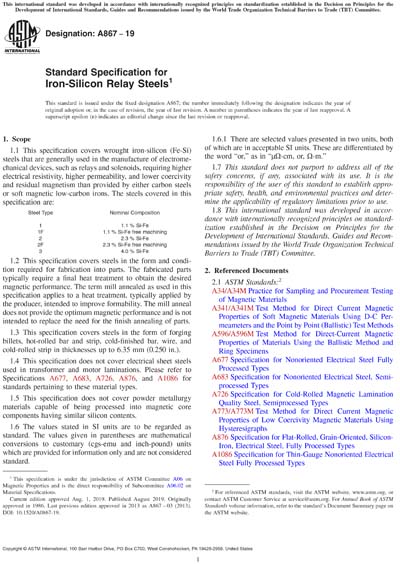Most recent
ASTM A867-19
Standard Specification for Iron-Silicon Relay Steels
1.1 This specification covers wrought iron-silicon (Fe-Si) steels that are generally used in the manufacture of electromechanical devices, such as relays and solenoids, requiring higher electrical resistivity, higher permeability, and lower coercivity and residual magnetism than provided by either carbon steels or soft magnetic low-carbon irons. The steels covered in this specification are:
1.2 This specification covers steels in the form and condition required for fabrication into parts. The fabricated parts typically require a final heat treatment to obtain the desired magnetic performance. The term mill annealed as used in this specification applies to a heat treatment, typically applied by the producer, intended to improve formability. The mill anneal does not provide the optimum magnetic performance and is not intended to replace the need for the finish annealing of parts.
1.3 This specification covers steels in the form of forging billets, hot-rolled bar and strip, cold-finished bar, wire, and cold-rolled strip in thicknesses up to 6.35 mm (0.250 in.).
1.4 This specification does not cover electrical sheet steels used in transformer and motor laminations. Please refer to Specifications A677, A683, A726, A876, and A1086 for standards pertaining to these material types.
1.5 This specification does not cover powder metallurgy materials capable of being processed into magnetic core components having similar silicon contents.
1.6 The values stated in SI units are to be regarded as standard. The values given in parentheses are mathematical conversions to customary (cgs-emu and inch-pound) units which are provided for information only and are not considered standard.
1.6.1 There are selected values presented in two units, both of which are in acceptable SI units. These are differentiated by the word “or,” as in “μΩ-cm, or, Ω-m.”
1.7 This standard does not purport to address all of the safety concerns, if any, associated with its use. It is the responsibility of the user of this standard to establish appropriate safety, health, and environmental practices and determine the applicability of regulatory limitations prior to use.
1.8 This international standard was developed in accordance with internationally recognized principles on standardization established in the Decision on Principles for the Development of International Standards, Guides and Recommendations issued by the World Trade Organization Technical Barriers to Trade (TBT) Committee.
Content Provider
ASTM International [astm]






